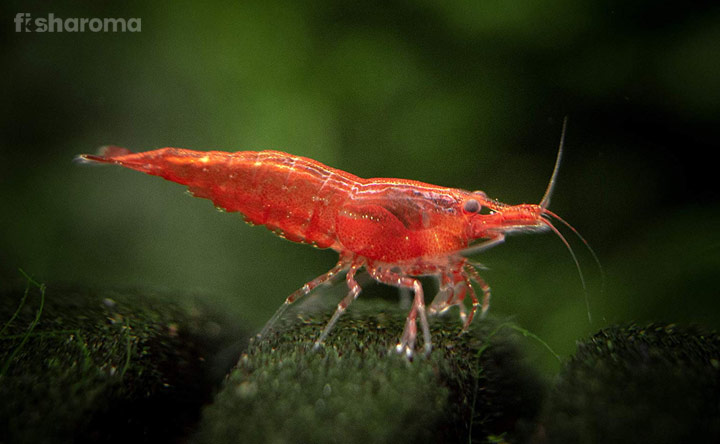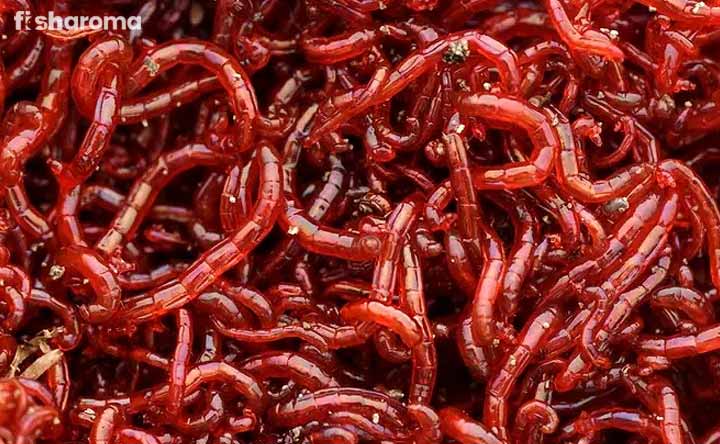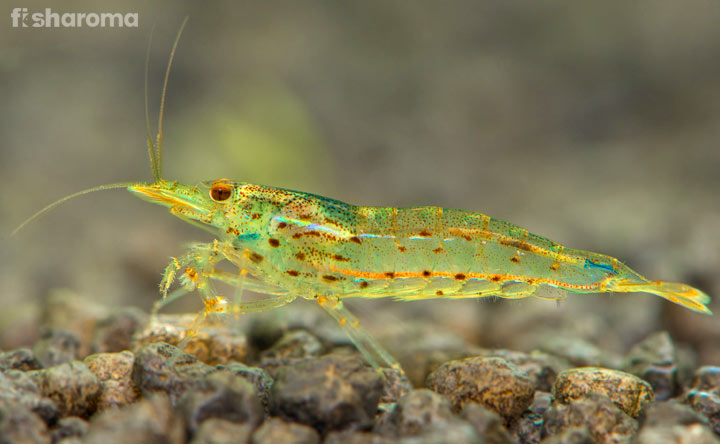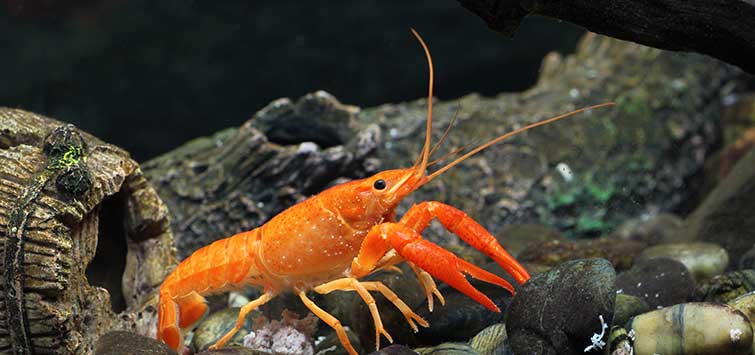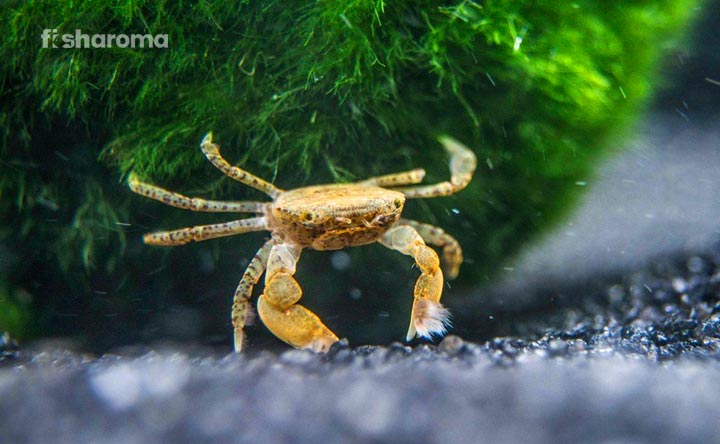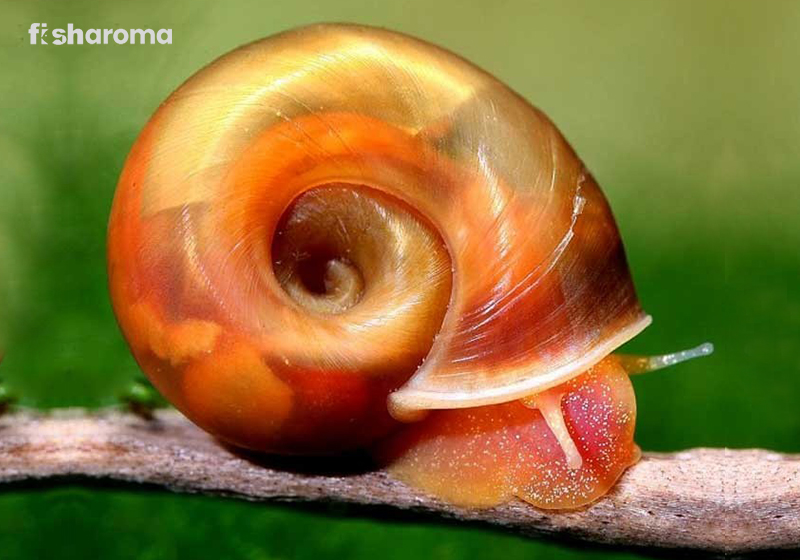Crystal Red Shrimp Care: All You Need to Know About
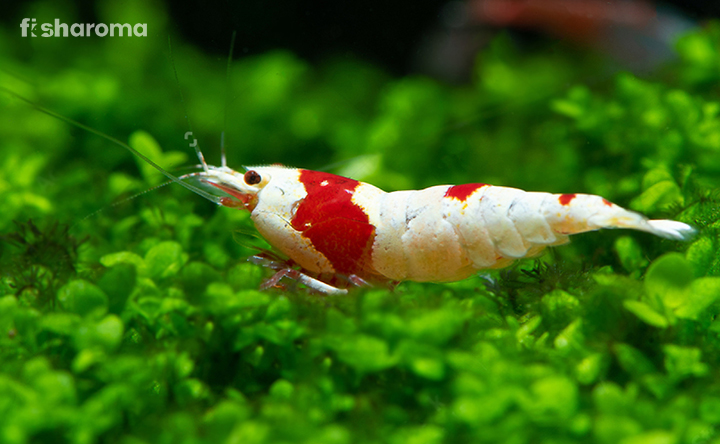
- Origin and Habitat of Crystal Red Shrimp
- Appearance of Crystal Red Shrimp
- Behaviour of Crystal Red Shrimp
- Lifespan of Crystal Red Shrimp
- Diet of Crystal Red Shrimp
- Tank Requirements for Crystal Red Shrimp
- Water Type for Crystal Red Shrimp
- Compatibility of Crystal Red Shrimp
- Breeding of Crystal Red Shrimp
- Diseases and Treatments of Crystal Red Shrimp
- Summary
The Crystal Red Shrimp is one of the colour variations of Bee Shrimps. Their colours are their USP, and we can totally relate to people wishing to own one. But, the catch is, they are not a wild-occurring species, so there is no natural reference in that case. That is why we are here, to exclusively guide you with their dietary needs, tank requirements, and more, so that you get an idea regarding the difficulty level of their maintenance. In turn, it will help you make an informed decision if you really can keep one or multiple.
Here we have some guidelines for you, especially for people already having such Shrimps. Read carefully and implement according to your pet’s needs.
Key Specifications of Crystal Red Shrimps
Following are the basic structure of their caring guide that you will find useful.
| Other Name | CRS (Abbreviation of the original name) |
| Origin | Japan |
| Lifespan | 1.5-2 years |
| Colours | Red and white combination |
| Temperament | Peaceful |
| Size | 1-1.5 inches |
| Diet | Omnivore |
| Compatibility | Social |
| Care Level | Moderately easy |
| Reproduction | Egg-layers |
| Tank Size | Min 10 gallons |
Overview
The dual-coloured species might seem intimidating to pet, but they are actually easy-going species to start with. Their peaceful temperament makes a wonderful tank mate out of them. The Crystal Red Shrimp is a sensitive yet short-lived creature, but that doesn’t steal its own thunder. They thrive well in freshwater environments and can be accommodated in small places themselves. Be it with or without tank mates, they don’t lose their natural charisma ever.
Origin and Habitat of Crystal Red Shrimp
The Crystal Red Shrimps are a result of the long term breeding of Bee Shrimps, more specifically, the Black Bumblebee Shrimp. It is the breeding experiment carried out under the guidance of Hisayasu Suzuki, that the first Shrimp with the specific red colouration occurred accidentally. It took around three generations to repeat the exclusive red and white colouration of the first specimen. Since then, it has been bred for this exquisite appearance only.
Although Bee Shrimps are native to the East Asian Country, Taiwan, the birth of Crystal Red Shrimp owes its origin to Japan only.
The breeding specimen doesn’t have any natural habitat, but since both of its parent (Bee Shrimp) species and its breeding surroundings are Asia, you can guess their environmental requirements, like the warm or cold weather. But as a continent, Asia displays varied geographical variations, so here we come to help you with an informative study regarding their habitat requirements precisely.
Appearance of Crystal Red Shrimp
The small-sized crustacean displays bi-colours or dual shades. However, since its occurrence is not natural and entirely depends upon breeding, there are some differences in the appearance amongst the Crystal Red Shrimp itself. Female shrimps have an overall bigger body than males, their scales are more prominent, so is their larger abdomen. Female ones have to care for and nurture their offspring, so their tail is even larger than their counterparts.
Size
The standard size for the adult Crystal Red Shrimp is 1-1.5 inches.
Colour
The characteristic colour combination of these Shrimps is red and white. The abdominal part of the Shrimp is banded with these two shades and this pattern is extended to the carapace or the head part as well. Although these stripes or bands do not have any particular order, many Shrimps might exhibit the two shades placed alternatively. The colours are, however, not equally dark in all specimens because they are subjected to breeding.
Breeding Shades
Based on their brightness and majorly the amount of white, they are divided into several categories, like A, S, S+, SS, SSS, and some variations might include B, C, SSSS as well. The higher the grade, whiter the Shrimp, and the lower the grade, the redder it is.
The highest category being the SSS, only includes Shrimps having 75% of white on the body while red is present only through some spotted patterns, that too around the carapace and abdomen.
The second-highest grade, i.e SS, denotes the Shrimp with complete white tails. The head or carapace is also white with a red shade on the lower part. The abdomen is red in this grade also. There is a common pattern in those Shrimps, that is a red spot on the abdomen often similar to the national flag of the country, and they are known as the Hinomaru, meaning the flag’s pattern.
The third highest grade is S+, where you can notice the abdomen is either red or translucent, but the carapace is out and out red. The overall body of the Shrimps can be termed red, with some whitish marks.
The S grade means more red than white, while the carapace or the head part is completely red but the abdomen is white. A continuous red stripe can be present in a linear way.
The A grade is mostly red, meaning 75% of its body is red with some itsy-bitsy white patterns.
However, there are some more gradations termed as B and C. Most of them are red, with irregular white markings on the body. The reason they are not considered of supreme quality is because of their less white marks and more reddish shade. Otherwise, they are pretty much the same. But it is believed that the S grade Shrimps are handy options for beginners breeders as these Shrimps need easy handling.
Behavior of Crystal Red Shrimp
The Shrimp displays pleasant behavioural traits like minding their own business as long as they get what they need in the tank. These Shrimps are social and don’t act strange around new tank mates. They stay mostly at the bottom of the tank and can’t swim much above that.
Like many other Shrimp species, Crystal Red Shrimps are sedentary during the daytime while their active hours start from the evening and continue till the morning. These Shrimps are found to be resting or hiding in any of their favourite corners inside the tank.
Moulting is another trait or rather a periodical thing for them where they shed their external casing of the body. These residues are supposed to be rich in calcium for them and you can see many of your Shrimps are eating their old casing. Many moulting Shrimps can stay in their hiding place unless their new casing is formed because they feel insecure without it. So, there is nothing alarming if you find old cases lying on the ground and you can’t find your Shrimps.
However, if deserted for too long, the cases can be detrimental for the tank, so removing them is advisable. But, the first preference should be given to your Shrimp, if they reject the casing, only then remove it.
Lifespan of Crystal Red Shrimp
The Crystal Red Shrimp lives for 1 to 2 years.
Diet of Crystal Red Shrimp
Wild Shrimps, regardless of their species and genus, are scavengers by nature. They can eat almost anything and everything. The same theory is applicable for Crystal Red Shrimps as well.
They are accustomed to digging out the bottom of the tank together. Gathering around the food source and feast along with family members is a common activity for them.
The outstanding fact is that they are capable of procuring their own food inside the tank, as there are some algae, microbes, and plant detritus in every aquarium. The frequency of giving outside food should be restricted to just once a day.
You can feed them after 2-3 days, only if you provide conducive conditions inside the tank that can help other organic lifeforms grow. In fact, a gap of a couple of days between two meal supplies is beneficial on multiple levels. On one hand, they get more chances to scavenge their own food, and there is no chance of being overfed which can be bad for their health. On the other hand, their stomach gets some rest and some time to revitalize it again.
Following are the names of the foods you can try giving them
- Daphnia
- Brine Shrimps
- Bloodworm
- Insect larvae
- Blanched vegetables like spinach, zucchini, and courgette
- Algae wafers and other sinking pellets
- Crushed flake meals
Indian Almond leaves are advantageous as they are prone to get some biofilm on themselves. So they are a convenient food source for Shrimp, apart from being a good option to balance the pH level of the tank.
Always provide foods that they can consume within 2-3 hours and not more than that, otherwise the rotten residue might pollute the tank set-up. If there is any left over, kindly use a vacuum gravel to remove it.
Tank Requirements of Crystal Red Shrimp
The small Crystal Red Shrimps don’t need bigger space for themselves. But they are extremely sensitive and can only thrive in particular conditions, which can be difficult to maintain in a nano tank or similar-sized things.
Tank Size
Crystal Red Shrimps can adjust in as minimum as a 5-gallon tank but for their complete well-being, they are best placed inside a 10-gallon tank.
Tank Lid
There is no specific requirement for the lid. It should be in accordance with the tank to prevent it from getting dirty.
Substrate
These Shrimps spend most of their time at the bottom of the aquarium, so ensure a smooth and soft gravel-based substrate. Smoothness is important to prevent any kind of injury for them.
Filter
These Shrimps don’t produce a lot of waste, so soft filtration is best for them. Also, they themselves are avid filter feeders that help keep the water clean. So, we recommend a Sponge filter for the aquarium as it maintains a stable flow of the water and also doesn’t pose any threat to the baby Shrimp-like sucking it up.
Ornaments
Besides plants, there is nothing extremely important, as far as the decoration is concerned. However, these Shrimps are not avid swimmers so you don’t have to worry about congesting their ways. You can install some hiding spots for their occasional respites. Driftwoods are recommended, as they can control a few things like releasing of tannins in the water, which is quite a healthy option. Also, it allows some micro-living forms to grow on it that can be an excellent food source for the Shrimp.
Lighting
They are comfortable in moderate lighting, that is neither extremely bright nor dim. Go for standard aquarium lights without a care in the world!
Presence of Flora
Well-chosen plants are important because these Shrimps feed off plant detritus. So, from algae-producing plants to anything that can also maintain the pH level of the water is of much importance. You can infuse the following plants like,
- Moss
- Water lettuce
- Duckweed
Both water lettuce and duckweed help maintain the nitrate level of the water down, keeping the water and fish both in prime condition.
Cleaning Method
The substrate needs to be cleaned using a gravel vacuum. There is usually no such waste directly caused by the Shrimp. But, you can always maintain cleanliness as it keeps unwanted outcomes like diseases at bay.
Water Type of Crystal Red Shrimp
The water should be warm with some moderate speed. Never use tap water as it might disrupt the otherwise balanced water.
Temperature
The range for ideal temperature should be between 16-25 Degrees Celsius. Higher heat is detrimental for the species.
pH Level
The suitable pH setting is 5.8 to 7.4.
Hardness
The water hardness should be within 4-6 dGH. The calcium carbonate concentration range is 0-4.
Mineral Level
The TDS or total dissolved solution range can be as minimum as 80 and as high as 200. Also, nitrite and ammonia should be 0 ppm. Even nitrate should ideally be 0 ppm, but if it extends, it should always stay under 20 ppm.
Replacement Procedure Water
Their sensibility has resulted because of their extensive breeding history, so they might be affected to even the slightest change. The shock will be detrimental, both physically and mentally, without any reason. So, change the 30% water on a weekly basis as it will maintain the flow and decrease the nitrate, without harming the Shrimp in any way.
If you add any new water, dechlorinate it on a priority basis, just to protect your Shrimp.
Compatibility of Crystal Red Shrimp
These calm species stay with their groups and don’t show territorial aggression to anything that may be put with them. The Shrimp are bottom-dwellers, so they are not going to attack any fish that mostly swim through on the top and middle part of the water. Still, it is always wise to pair creatures that are similar in nature.
Suitable Tank Mates
The suitable tank mates for these peaceful Crystal Red Shrimp are
- Amano Shrimp
- Bamboo Shrimp
- Zebra Danios
- Cherry Barb
- Neon Tetras
- Snails
They are an ideal selection to be put inside a species tank, especially if you keep them in groups. You can easily have one aquarium exclusively devoted to these shrimps, but you can’t watch them throughout the day, so that has to be your call if you want some tank mates or not.
Unsuitable Tank Mates
Big and overpowering fishes are not suitable, as they can easily eat these Shrimps. They are easy targets for the preying fishes, because of their colouration. Crystal Red Shrimps are usually unfazed by any other entities in the tank, but if there are intimidating fishes that pose a threat to the Shrimp, then the latter is petrified. So, avoid any such fishes on a priority basis.
Breeding of Crystal Red Shrimp
Given the right condition, adult Shrimps mate naturally and you don’t need to set up a breeding tank prior to that. The water temperature should be around 23 Degrees Celsius for their breeding. Warmer temperatures than that will affect the hatchlings’ lifespan. The breeding ritual is followed by female Shrimps releasing some pheromones to notify their male partners that they are ready for mating.
Female Shrimps carry their eggs inside their abdomen for about 30 days, in the meantime, they constantly fan the eggs, using their swimmerets. The offspring hatch and they are pretty independent from the beginning. But you can always provide baby Shrimp food in powdered form for them. After 4-5 weeks, they attain maturity and become ready to breed.
Temperament wise, Cherry Shrimps are good companion options for Crystal Red Shrimps, but the two types of Shrimp can breed with each other, resulting in some not so fancy-looking progeny, unlike their parents. Also, the thriving temperatures for Red Cherry Shrimp are lower than these Crystal Red Shrimps, so, housing them will result in compromising with either of their comfort levels.
Diseases of Crystal Red Shrimp
The delicate species are extremely susceptible to sudden water change and temperature fluctuation. This is why you need to maintain the above-mentioned water parameters all the time.
Also, directly introducing or adding new Shrimps to the already existing Shrimps might induce some parasitic, bacterial, as well as fungal infections. Before adding any new Shrimps, regardless of their number, quarantine them for a minimum of 1 week to prevent such unnecessary diseases.
Summary
The docile, peaceful, and beautiful species is prone to get affected quickly even by the slightest of their environmental change. Caring for them takes dedication and perseverance. Their lifespan is short, but due to their rapid growth and extensive breeding tendency, their numbers are often refilled with a blink of an eye. The Crystal Red Shrimps do not have any temperamental issues with each other, not even during breeding, so they are an absolutely pleasant species to come across.
Some Similar Care Guides
If the above article has caught your attention, you might like to take a quick look at the care guide of Crystal Red Shrimp’ compatible mates.
- Cherry Barb – The social species swim in low-lighted and slow moving waters. They are tiny yet spectacular, making a wonderful pet option for aquarium hobbyists.
- Bamboo Shrimps – The Southeast Asian species share similar nature and requirements with Crystal Red Shrimp. They can stay with other species in the tank as well.
- Amano Shrimps – The beautiful Shrimp with a translucent body can change its color based on their diet. An amazing addition to any aquarium, they are pretty peaceful.


